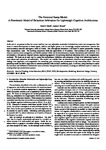The extended ramp model: A biomimetic model of behaviour arbitration for lightweight cognitive architectures
| dc.contributor.author | Gaudl, Swen | |
| dc.contributor.author | Bryson, JJ | |
| dc.date.accessioned | 2019-10-30T10:31:23Z | |
| dc.date.available | 2019-10-30T10:31:23Z | |
| dc.date.issued | 2018-08 | |
| dc.identifier.issn | 1389-0417 | |
| dc.identifier.issn | 1389-0417 | |
| dc.identifier.uri | http://hdl.handle.net/10026.1/15086 | |
| dc.description.abstract |
In this article, we present an idea for a more intuitive, low-cost, adjustable mechanism for behaviour control and management. One focus of current development in virtual agents, robotics and digital games is on increasingly complex and realistic systems that more accurately simulate intelligence found in nature. This development introduces a multitude of control parameters creating high computational costs. The resulting complexity limits the applicability of AI systems. One solution to this problem it to focus on smaller, more manageable, and flexible systems which can be simultaneously created, instantiated, and controlled. Here we introduce a biologically inspired systems-engineering approach for enriching behaviour arbitration with a low computational overhead. We focus on an easy way to control the maintenance, inhibition and alternation of high-level behaviours (goals) in cases where static priorities are undesirable. The models we consider here are biomimetic, based on neuro-cognitive research findings from dopaminic cells responsible for controlling goal switching and maintenance in the mammalian brain. The most promising model we find is applicable to selection problems with multiple conflicting goals. It utilizes a ramp function to control the execution and inhibition of behaviours more accurately than previous mechanisms, allowing an additional layer of control on existing behaviour prioritization systems. | |
| dc.format.extent | 1-9 | |
| dc.language | en | |
| dc.language.iso | en | |
| dc.publisher | Elsevier BV | |
| dc.rights | Attribution-NonCommercial 4.0 International | |
| dc.rights | Attribution-NonCommercial 4.0 International | |
| dc.rights | Attribution-NonCommercial 4.0 International | |
| dc.rights | Attribution-NonCommercial 4.0 International | |
| dc.rights | Attribution-NonCommercial 4.0 International | |
| dc.rights.uri | http://creativecommons.org/licenses/by-nc/4.0/ | |
| dc.rights.uri | http://creativecommons.org/licenses/by-nc/4.0/ | |
| dc.rights.uri | http://creativecommons.org/licenses/by-nc/4.0/ | |
| dc.rights.uri | http://creativecommons.org/licenses/by-nc/4.0/ | |
| dc.rights.uri | http://creativecommons.org/licenses/by-nc/4.0/ | |
| dc.subject | Reactive planning | |
| dc.subject | Action selection | |
| dc.subject | BBAI | |
| dc.subject | POSH | |
| dc.subject | BOD | |
| dc.subject | Bio-inspiration | |
| dc.subject | Modelling | |
| dc.subject | Behaviour design | |
| dc.subject | Curiosity | |
| dc.title | The extended ramp model: A biomimetic model of behaviour arbitration for lightweight cognitive architectures | |
| dc.type | journal-article | |
| dc.type | Journal Article | |
| plymouth.author-url | https://www.webofscience.com/api/gateway?GWVersion=2&SrcApp=PARTNER_APP&SrcAuth=LinksAMR&KeyUT=WOS:000432567500001&DestLinkType=FullRecord&DestApp=ALL_WOS&UsrCustomerID=11bb513d99f797142bcfeffcc58ea008 | |
| plymouth.volume | 50 | |
| plymouth.publication-status | Published | |
| plymouth.journal | Cognitive Systems Research | |
| dc.identifier.doi | 10.1016/j.cogsys.2018.02.001 | |
| plymouth.organisational-group | /Plymouth | |
| plymouth.organisational-group | /Plymouth/Faculty of Science and Engineering | |
| plymouth.organisational-group | /Plymouth/Faculty of Science and Engineering/School of Engineering, Computing and Mathematics | |
| plymouth.organisational-group | /Plymouth/REF 2021 Researchers by UoA | |
| plymouth.organisational-group | /Plymouth/REF 2021 Researchers by UoA/UoA11 Computer Science and Informatics | |
| plymouth.organisational-group | /Plymouth/Users by role | |
| plymouth.organisational-group | /Plymouth/Users by role/Academics | |
| dcterms.dateAccepted | 2018-02-22 | |
| dc.identifier.eissn | 1389-0417 | |
| dc.rights.embargoperiod | Not known | |
| rioxxterms.versionofrecord | 10.1016/j.cogsys.2018.02.001 | |
| rioxxterms.licenseref.uri | http://creativecommons.org/licenses/by-nc/4.0/ | |
| rioxxterms.licenseref.startdate | 2018-08 | |
| rioxxterms.type | Journal Article/Review |



